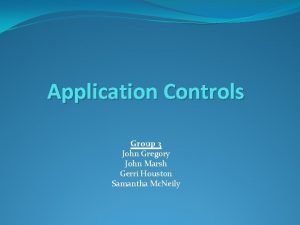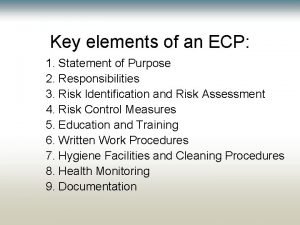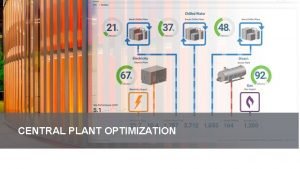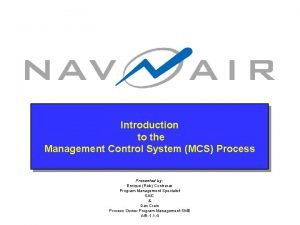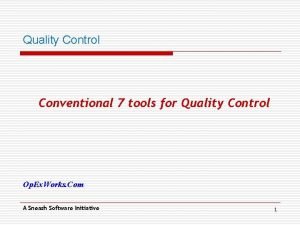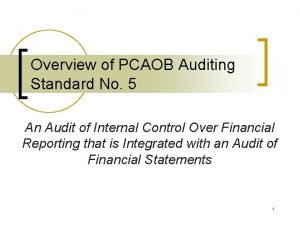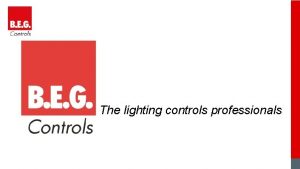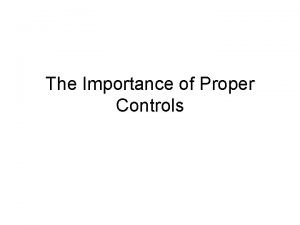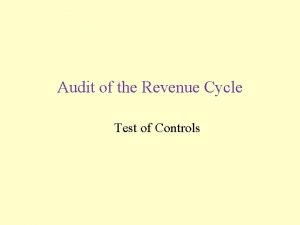Marx Modulators RF Controls P 1 Marx 10





































- Slides: 37

Marx Modulators RF Controls P 1 Marx 10 MW Klystron • P 1 Marx: has operated over 5 khr although at half pulse length this year due to capacitor lifetime problem – will upgrade with zinc versions • P 2 Marx: has lower voltage cells with individual droop control – being assembled • In FY 12, no funding for new development, but – P 1 and P 2 will be long-term tested – A SBIR funded DTI Marx will be evaluated – A new 10 MW MBK will be acquired Toshiba 10 MW Multi-Beam Klystron (MBK) Chris Adolphsen

ILC Klystron Modulator • Performance requirements – 120 k. V peak voltage – 140 A peak current – 1. 6 ms pulse width – 5 Hz pulse repetition frequency – +/- 0. 5% flat top – 134 k. W average power – <20 J deposited into klystron from gun spark

P 1 Marx +Toshiba 10 MW MBK Performance Kirk Bertsche

Operation History 750 ms Pulse Length 10 Months: Nov 2010 thru Aug 2011

Marx P 1 System Faults 31 Total Faults Nov 2010 thru Aug 2011 • Majority of faults due to facilities interlocks (e. g. waveguide pressure, cooling water flow) • One modulator problem, June 2011 – Arc on backplane, induced by corona – Corona prevention measures taken on new backplane – No recurrence of problem

RF Pulse Flatness Pulse flat to within 0. 5%

Modulator Power Correlations

Modulator Voltage Correlations Toshiba measured a m. P of 3. 16

P 2 Marx Design Considerations • Compatibility with two-tunnel design • High availability • Low-cost • Ease of maintenance • Portability of design to future applications

Modulator Topology • High Availability – Each cell provides a regulated output – Modulator has N+2 redundancy • Low Cost – Marx is inherently modular. Large quantities allow for an economy of scale • Portability of Design – PEBB approach to allow cells (building blocks) to be arranged differently for different output requirements

RF System Overview 4. 2 k. V DC 3 phase 480 V DC Power Supply DCRack 1. 2 k. V DC Marx Modulator DC 32 Cells pulsed 120 k. V Klystron DC RF out

Marx Basics • Classic description: +Vin Marx “cell” Charge in Charge out • SLAC P 2 Marx Solid State Implementation: Cell in Cell out

Voltage SLAC P 2 Marx Cell Schematic Time

Correction Scheme Cell Output Current Cell Output Voltage Main IGBT Vce PWM Inductor Current

Ripple Cancelation 2 cells switching in phase 2 cells switching 180 o out of phase

Switching • High availability -> To simplify control, improve protection, and enhance diagnostic access, the Marx cells do not contain arrays of switches • No need to push the device state-of-the-art with this application. Operation is “within the datasheet” 6. 5 k. V IGBT half-bridge 1. 7 k. V IGBT half-bridge 6. 5 k. V dual diode module Common heat sink

Switching • Switch (and cell) first level protection is accomplished at the gate drive level – Over voltage, over current, over di/dt (b) 140 A IGBT Ic 4 k. V (a) IGBT Vce (b) IGBT Vge • At left, load arc is triggered at (a). Current rises through IGBT. • After fault is detected, gate drive initiates turn-off. • Active voltage clamping is achieved by partially turning device back on, (b).

Controls • High Availability – System has abundant real-time diagnostic access – Prognostics built into software – Auto-reconfiguration possible • Portability of design – Controls hardware used on several projects – High-level applications have potential use in several areas

Modulator Control System Application Manager Gigabit Ethernet + fiber optic trigger Cell 1 Hardware Manager GD 1 GD 2 GD 3 Cell 2 Hardware Manager GD 1 GD 4 GD 2 GD 3 Cell 32 Hardware Manager GD 1 GD 4 GD 2 GD 3 GD 4

Control System • Twelve 12 -bit, 1 MS/s ADCs per cell – 4 voltage monitors, 1 -2 LEMs, 2 shunts, 3 temperature monitors, 1 spare • Potential future addition of four 8 -bit, 10 MS/s ADCs per gate drive – Vge, Vce, Ic, Vce, sat • System-level monitoring – Includes output voltage, current, system temperatures

Packaging • Ease of maintenance – Oil-free design! • Easy to get in and get out (low MTTR) – Cells less than 50 lbs – All cell parts easy to access – Maintenance is at the shop, not at the modulator • Portability of design – Cells designed to be easily scalable

Packaging

P 2 Being Assembled

Status • Cell fabrication is finishing up – Was delayed by 7 month capacitor delivery delay • Cells have been tested in an array of six • DC power supply rack is finished • Switching to water load for larger arrays of cells • Enclosure is 80% done – Need to install air ducts, cooling system, and remaining field shapers

Thompson Modulator for XFEL

Thompson Modulator

DTI MARX MODULATOR Rosa Ciprian

ARCHITECTURE D 1 Pulse D 2 Recharge • High energy • Recharge via switch • Dual cell approach: core = 6. 5 k. V corrector = 900 V • Minimize overall size and possibly $ by using electrolytic capacitors • Pulse shaping via feedback

CORE MODULES • 6. 5 k. V cell • 8. 2 k. J electrolytic capacitors • 4 switches for pulsing and 4 for recharging • All 20 modules fired simultaneously, (D 1 is not needed)

CORRECTOR MODULES • 900 V cell • 340 J caps • MOSFETs for pulsing and recharging • Modules fire for droop remediation (feedback)

ASSEMBLY • Modulator tank footprint ~1. 5 m x 2. 5 m • Height ~ 2 m including controls (doghouse) • Local controls in front panel and remote in the rear panel.

Full Voltage/Current/PW Spec Voltage: 120 k. V Current: 130 A Pulse width: 1. 5 ms Ch 4: Command Ch 1: Pulse current 40 A/V Ch 2: Voltage 15 k. V/V Ch 3: Feedback integrated control • Modulator has demonstrated full spec single pulsing into a resistive load. • Due to source and load limitations, full spec pulsing has been demonstrated at 5 Hz with a double full PW pulse, three 1 ms pulses and ten 150 us pulses.

VOLTAGE REGULATION • User controls voltage regulation set point with front panel controls. • User needs to adjust core and corrector voltages (buck regulators) to the pulse requirement. • Scope shot shows ability to control the regulation point (blue cursor). • Green trace indicates sequencing of pulse correction

CONTROLS AND FAULTS • Controls provide protection from over-current, tank overheating, control power problems and invalid command requests. • A main interlock controls chopper power supplies, HV dump relays and is in series with an external user interlock. • Max rep rate: the limit is set at 5. 1 Hz, after that limit it starts skipping pulses. • Max pulse width: at 1. 542 ms, if commanded a wider pulse, the pulse gets cut to the limit. • Both these faults do not produce a hard fault, and pulsing continues by skipping pulses to adjust to max rep rate or cutting the pulse width. The error will show up just as a flashing light in the front panel “pulse error”.

REMOTE CONTROLS • Support of complete remote controls suitable for a PLC interface • Uses TTL level signals as well as analog signals • Signals available for monitoring output parameters, run status, and faults available in the rear panel.

QUALIFICATION • • • Performed by SLAC @ DTI Aug 22 -26. With and without correction at 120 k. V, 136 A, 1. 54 m. S. Experiments were performed with just 15 correctors. The load DTI had was about 910Ω which ask for more current than the original requirement of 120 k. V/120 A. Output cable length: The output cable was about 20 ft, emulating a longer cable required installation of a 700 pf 150 k. V capacitor, that was added to the resistive load. No significant change at the output. Regulation: The regulation feedback seems to be appropriate. Calibration of the correctors was performed. Because of the source and load limitations full rep rate cannot be tested at DTI. Two pulses regulated at 120 k. V/130 A, 1. 5 m. S/5 Hz, where the supply is still recharging the caps, we could see a small degradation on the second pulse due to lack of supply power. Also three pulses at 120 k. V/130 V 1 m. S 5 Hz and 10 pulses 120 k. V/130 A 150 u. S 5 Hz. Arc testing: Using a spark gap at 120 k. V/130 A with regulation. After arc we validated that all modules were firing as required, and the modulator was firing full specs pulses.

DELIVERY AND INSTALLATION DELIVERY • The modulator will be shipped dry. It will be delivered with a 10 m output cable DS 2077 (un-terminated at klystron end) and a 10 m input cable RG 8 (un-terminated at the supply end). • One assembled core and one corrector together with available spare parts will be part of the delivery. DTI is working on the inventory of spares. INSTALLATION REQUIREMENTS • 10 GPM cooling water, manifolds and water interlocks. • 208 VAC 3 phase (30 A breaker) for controls. • 7 -10 k. V rectified unregulated supply for main power. • Oil: ~734 gallons Diala or mineral oil. • Analysis of seismic compliance. • Secondary oil containment.
 Magnet for modulators
Magnet for modulators Stfc frequency modulators mk2
Stfc frequency modulators mk2 General controls vs application controls
General controls vs application controls He who controls the past controls the future
He who controls the past controls the future Administrative controls examples
Administrative controls examples 7 steps of dry sanitation
7 steps of dry sanitation What controls the operation of a pulse-wiper system?
What controls the operation of a pulse-wiper system? Central plant optimization
Central plant optimization Cash disbursement cycle
Cash disbursement cycle Mcs process
Mcs process Cci controls lp gas detector
Cci controls lp gas detector What are the three primary flight controls?
What are the three primary flight controls? Iso 27001 domains, control objectives and controls
Iso 27001 domains, control objectives and controls Autoclave principle
Autoclave principle Sbu m-form structure
Sbu m-form structure Foot protection examples
Foot protection examples The autonomic nervous system controls
The autonomic nervous system controls When there is no more room in hell
When there is no more room in hell Entity level control
Entity level control Revenue cycle audit objectives
Revenue cycle audit objectives When an object moves, it acquires
When an object moves, it acquires Euc governance
Euc governance Johnson controls international kft
Johnson controls international kft Corrective controls examples
Corrective controls examples Corrective controls examples
Corrective controls examples The pcv system controls which exhaust emission(s)?
The pcv system controls which exhaust emission(s)? Fraud internal control and cash
Fraud internal control and cash Quality controls for conventional techniques
Quality controls for conventional techniques Operating system controls
Operating system controls Directorate of defense trade controls
Directorate of defense trade controls Pcaob auditing standard 5
Pcaob auditing standard 5 Lc&d lighting controls
Lc&d lighting controls Corrective controls reveal or discover unwanted events.
Corrective controls reveal or discover unwanted events. Guidelines for selecting proper device based controls
Guidelines for selecting proper device based controls Corrective controls examples
Corrective controls examples Establish accurate controls
Establish accurate controls Auditing the revenue cycle test bank
Auditing the revenue cycle test bank Bank reconciliation internal controls
Bank reconciliation internal controls


